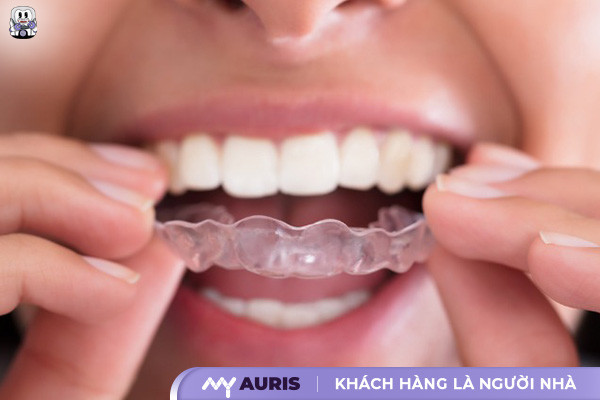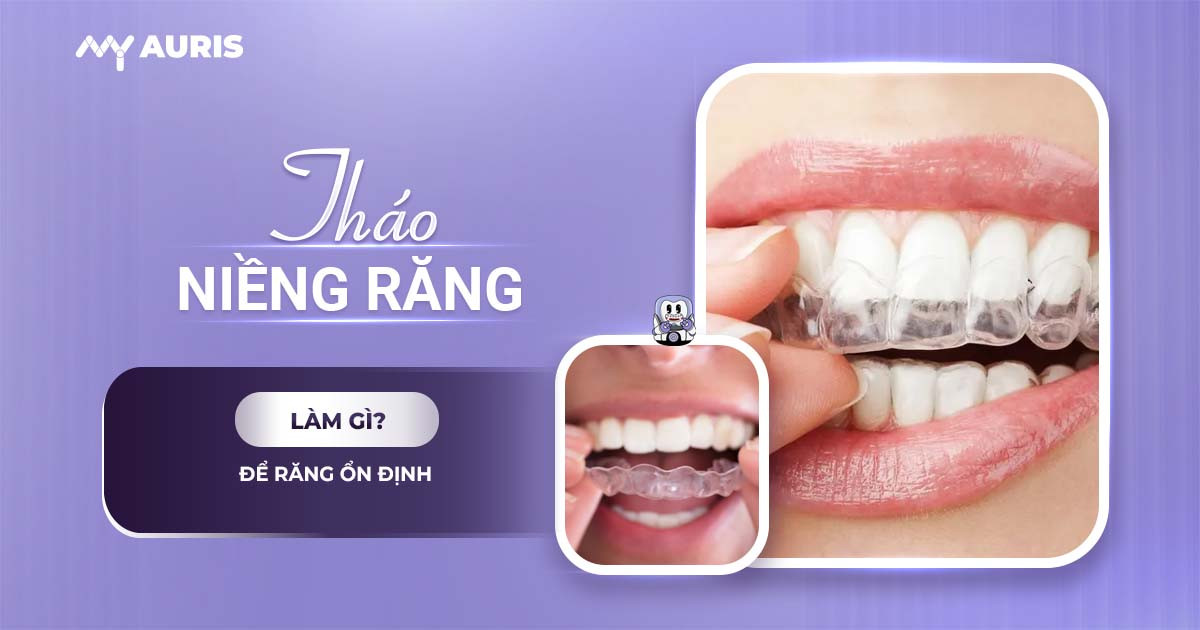Orthodontic braces are a modern orthodontic solution that helps improve occlusion and enhance smile aesthetics. After a treatment process lasting 18 to 24 months, the moment of braces removal always brings a special feeling to the patient. However, not everyone fully understands how the braces removal process works and what precautions are needed to preserve the results achieved after removal. In this article, the orthodontic specialist at My Auris will share detailed insights from practical experience, helping you understand each step and the proper care after braces removal.
What to do after braces removal to prevent teeth from shifting back?
Wear a retainer as prescribed by the dentist
Immediately after braces removal, wearing a retainer as prescribed by the dentist is mandatory to help teeth stabilize quickly and maintain long-term orthodontic results. Depending on each case, the duration of wearing the retainer varies to ensure jawbone stability, fixed teeth, and no risk of shifting.
Currently, there are two common types of retainers: fixed retainers and removable retainers. Among them, clear removable retainers are favored for their high aesthetics and convenience for patients, suitable for both traditional braces and clear aligners.
However, many people are complacent or too eager to remove their braces and skip this stage, leading to relapse of misaligned teeth after orthodontics, causing teeth to shift back to their original position and requiring retreatment, which is costly in terms of time and money.

Proper oral care after braces removal
The dentist always emphasizes: proper oral hygiene is indispensable after braces removal. This helps effectively clean teeth, ensuring they don’t stain, develop cavities, or suffer from gingivitis.
You should:
- Brush your teeth regularly twice a day, using a fine-bristled or soft-bristled toothbrush to quickly remove plaque without damaging teeth or gums.
- Brush your teeth correctly, avoiding brushing too hard or too fast as it can harm soft tissues and reduce cleaning effectiveness.
- Combine with dental floss to clean food debris and bacteria between teeth; do not use toothpicks as they can easily create gaps due to strong impact on the gums.
- Rinse with saltwater or specialized mouthwash for higher cleaning effectiveness, keeping your mouth fresh.
Don’t forget to clean your retainer as instructed, and store it in its case when not in use to prevent breaking or damaging it, which would incur unnecessary costs.
Additionally, avoid bad habits such as biting pens, thumb sucking, and teeth grinding, as these can cause teeth to shift back to their original positions.
Diet after braces removal: Impact on orthodontic results
When your teeth are not yet stable after braces removal, your diet can directly affect the orthodontic results. You need to:
- Establish a nutritionally complete diet, prioritizing vitamins and minerals from cereals, eggs, poultry, milk, dairy products, vegetables, and various fruits.
- Limit foods high in sugar and starch as they increase the risk of plaque formation and bacteria on teeth, easily leading to oral diseases.
- Avoid foods that are too hot or too cold to prevent irritation to sensitive teeth and gums.
- Absolutely do not consume excessively hard or chewy foods that require strong chewing force, as this can weaken teeth and lead to more severe instability.
- Do not smoke, drink alcohol, or use stimulants as they can damage gums, harm your teeth, and overall body health.

Regular dental check-ups to monitor stability
Finally, don’t forget to have regular dental check-ups as scheduled for a general oral examination and to monitor any abnormal shifts. The dentist will also assist with oral hygiene using dental equipment to prevent early oral diseases.
Note: If you notice any abnormal shifting, you should contact your treating dentist immediately for timely intervention, as delaying could make correction more difficult and incur additional treatment costs.
What is the braces removal process like?
When the time comes to conclude the orthodontic treatment, the braces removal process is the final but extremely important step. Many wonder if braces removal is painful, how long it takes, and what needs to be done afterward to ensure stable results. Here is detailed information from dental experts to put your mind at ease.
Typically, the braces removal process takes about 60 minutes and involves 3 basic steps, but it must be performed with correct technique to avoid damaging or shifting the teeth.
Gentle and precise bracket removal
For cases using fixed braces, the dentist will start by removing the archwire from the system. Then, specialized dental pliers are used to remove each bracket, combined with a debonding agent to break down the adhesive layer securing the bracket to the tooth surface. This process is carried out meticulously to avoid damaging the teeth, causing pain, or affecting tooth structure.
Some people might feel a slight sensitivity in their teeth because they are still a bit weak at this stage, but this sensation is not overly uncomfortable and will quickly subside.

Teeth cleaning and enamel polishing
After bracket removal, the dentist proceeds to clean the teeth, removing adhesive residue, and then polishes the tooth surface. This helps teeth become whiter, shinier, and healthier-looking naturally after orthodontic treatment.
⏱ The teeth cleaning and enamel polishing process takes approximately 5 – 10 minutes. You might experience some sensitivity during polishing, but this is a normal sensation and will disappear once the polishing is complete.
Retainer wear cannot be overlooked after braces removal
Wearing a retainer is an extremely important step after braces removal to keep the teeth in their desired position according to the treatment plan. Since teeth are still weak after braces, if a retainer is not worn, teeth may shift or become misaligned, affecting the bite, especially during eating or when subjected to external factors.
In reality, many people do not wear their retainers after braces removal, leading to teeth shifting, not fitting together properly, and an incorrect bite within just a few months.
Modern dental technology today allows for retainers to be designed to the exact dimensions of each patient, providing comfort and high effectiveness. However, to ensure stable and long-lasting results, you should wear your retainer as prescribed by the orthodontic specialist.
Frequently asked questions about braces removal
Can braces be removed early?
Early braces removal is always a concern for many patients, especially when they want to know if braces can be removed earlier than the time prescribed by the dentist. However, to ensure the post-orthodontic results, most dentists advise removal strictly according to the treatment plan. If necessary, the dentist may allow removal 1 to 2 months earlier, but this still depends on the specific oral condition of each individual.
Absolutely do not attempt to remove brackets yourself without the dentist’s consent. Removing braces earlier than planned is not recommended by dentists, as it can lead to undesirable consequences such as: teeth easily shifting, difficulty chewing due to teeth not being stable, a weak bite, and interruption of the orthodontic process.
Can braces be removed temporarily?
Some patients wonder if temporary braces removal is possible, especially for reasons like a wedding or occasions where braces cannot be worn for a period. The answer from the dentist is yes – provided this is done correctly and with the dentist’s approval.
For temporary removal, the dentist will remove the brackets temporarily, then take impressions to ensure that braces can be reapplied in the correct position after the interruption, thereby ensuring the orthodontic process continues according to the previously established treatment plan.
Do teeth become weaker after braces removal?
Many people mistakenly believe that teeth become weaker after braces removal, but in reality, teeth do not weaken. On the contrary, teeth become stronger because they are no longer misaligned, oral hygiene is easier, and chewing forces are better directed. However, whether teeth remain strong or become weaker also depends on proper oral hygiene and protection after braces removal.
A correct understanding of the braces removal process, whether for early removal or temporary removal, will help you feel more at ease during the process. Always listen to your dentist’s advice, follow instructions precisely, and provide proper care—these are key to maintaining strong teeth and durable orthodontic results.





